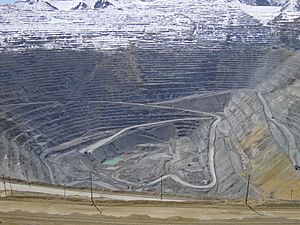Economy of Utah facts for kids
The economy of Utah is like a big puzzle with many different pieces, meaning it has many different ways people earn money and create goods. These include things like tourism, mining, agriculture (farming), making things (manufacturing), information technology (computers and software), finance (money and banking), and making petroleum products. Most of Utah's economic activity happens along the Wasatch Front, which is where the capital city, Salt Lake City, is located.
In 2021, the total value of all goods and services produced in Utah was about $220 billion. This shows how much wealth the state creates. Some of the main ways people make a living in Utah include mining for coal, raising cattle, producing salt, and working for the government. Utah is known for having a strong and growing economy, especially in new and innovative industries.
Utah has different types of taxes. The state collects a personal income tax at a single rate of 5%. However, it gives tax credits to families with lower or middle incomes. This helps make the tax system fairer for everyone. There is also a state sales tax of 4.65% on most things you buy. Cities and counties can add their own local sales taxes, so the total sales tax can be different depending on where you are. Property taxes are collected by local governments. Utah does not tax things like intangible property (like patents) or charge an inheritance tax when someone passes away.
Over time, droughts in Utah have become more common and severe, partly due to climate change. These droughts can make it harder for the state to get enough water, which can affect different parts of the economy.
Contents
Farming and Agriculture
Farming is very important in the rural areas of Utah. Even though the land can be dry, farmers are able to grow crops like corn and barley. Only a small part of Utah's land is used for farming, including farms in river valleys and areas where farmers use special "dry farming" methods.
Most of the money from agriculture in Utah comes from livestock (farm animals) and products made from them. This includes raising sheep and cattle, dairying (producing milk), and a growing poultry (chicken and turkey) industry. Utah gets a lot of sunshine, which helps with farming, even if there isn't much rainfall. The weather is usually mild, which allows for a good amount of fruit production.
Tourism and Outdoor Fun
Tourism is a huge industry in Utah because it's famous for outdoor activities all year round. Utah has five amazing national parks: Arches, Bryce Canyon, Canyonlands, Capitol Reef, and Zion. This means Utah has the third most national parks of any state, after Alaska and California.
Besides national parks, Utah also has seven national monuments, two national recreation areas, six national forests, and many state parks. These places offer lots of opportunities for hiking, camping, and exploring nature.
Winter Sports in Utah
Utah is especially well known for its winter activities, like skiing and snowboarding. Tourism for winter sports has grown a lot since the 2002 Winter Olympics were held here. Skiing in Utah started in 1939 with the opening of Alta Ski Area and has become famous worldwide. Park City is even home to the United States Ski Team.
Most of Utah's ski resorts are in northern Utah, close to Salt Lake City, Park City, Ogden, and Provo. In 2008, Deer Valley in Park City was named the top ski resort in North America by Ski Magazine for the second year in a row. Skiers love Utah's resorts because they have great snow and excellent facilities. They are also easy to get to from Salt Lake City's airport and are close to other resorts, so people can visit many different places in one trip.
Olympic Legacy
The 2002 Winter Olympics were a big boost for Utah's economy. Many new buildings and facilities were built for the Olympics, and these still help bring tourists to the state. Former Olympic venues like Utah Olympic Park and Utah Olympic Oval are still used for training and competitions. The public can even try out activities like ski jumping, bobsleigh, and speed skating at these places.
Cultural Attractions
Utah also has many cultural attractions. These include Temple Square in Salt Lake City, which is a popular religious and historical site. The Sundance Film Festival in Park City is a famous event where new movies are shown. In Cedar City, you can enjoy the Utah Shakespearean Festival, which performs plays by William Shakespeare.
Other popular places to visit in Utah are Monument Valley with its unique rock formations, the huge Great Salt Lake, the flat and shiny Bonneville Salt Flats, and Lake Powell, which is a large reservoir.
Mining in Utah
Mining has been a very important part of Utah's economy for a long time, starting in the late 1800s. The Bingham Canyon Mine, southwest of Salt Lake City, is one of the world's largest open-pit mines. When mining first boomed, it attracted many immigrants who came to Utah for job opportunities.
Many towns in Utah grew up around mining, like Mercur, Silver Reef, Eureka, and Park City. There were also many coal mining towns in Carbon County, such as Castle Gate and Hiawatha. These towns often experienced "boom and bust" cycles, meaning they grew very quickly when mining was good and then struggled when it slowed down.
During the early part of the Cold War, uranium was mined in eastern Utah. Today, mining is still a major industry. Minerals found in Utah include copper, gold, silver, molybdenum, zinc, lead, and beryllium. Fossil fuels like coal, petroleum (oil), and natural gas are also very important to Utah's economy, especially in the eastern parts of the state.
Energy Production
Wind Power


